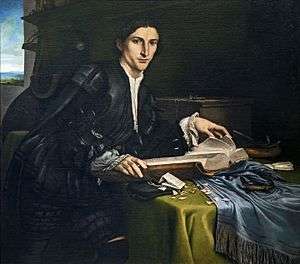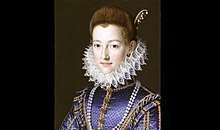Pier Francesco Orsini
Pier Francesco Orsini (July 4, 1523 – January 28, 1583), also called Vicino Orsini, was an Italian condottiero, patron of the arts and duke of Bomarzo.[1] He is famous as the commissioner of the Mannerist Park of the Monsters in Bomarzo (northern Lazio).[1]
Vicino Orsini | |
|---|---|
 | |
| Condottiero | |
| Duke of Bomarzo | |
| Patron of the arts | |
| Personal details | |
| Born | Pier Francesco Orsini July 4, 1523 |
| Died | October 28, 1585 (aged 62) |
| Nationality | Italian |
| Spouse(s) | Giulia Farnese |
| Mother | Clarice Orsini di Franciotto di Monterotondo |
| Father | Giovanni Corrado Orsini |
| Occupation | Politician |
| Religion | Epicureanism |
| Military service | |
| Battles/wars | Treaty of Cateau-Cambresis |
Biography
Born in Corigliano Calabro, he was the son of Giovanni Corrado Orsini and Clarice Orsini di Franciotto di Monterotondo[2], the daughter of Cardinal Franciotto Orsini[3] and Violante di Vicino Orsini di Foglia[4]. «Franciotto Orsini of Monterotondo married Violante Orsini di Castello, daughter of Pierfrancesco I Orsini, also known as Vicino, who was lord of Bomarzo and transmitted the rights to the fief to the daughter. Franciotto was educated with his aunt in the house of Lorenzo and a native of Giovanni de Medici who, once a pope, named the cousin who had just been widowed a cardinal.»[5]
Vicino Orsini inherited the duchy of Bomarzo seven years after the death of his father, thanks to an intercession by Alessandro Cardinal Farnese (the future Pope Paul III). He later married Alessandro's relative Giulia Farnese, not to be confused with her maternal great-aunt and the cardinal's sister Giulia Farnese, the mistress of Pope Alexander VI. His wife Giulia Farnese (d. 1564) was the daughter of Galeazzo Farnese, Duke of Latera and Isabella, daughter of Giuliano dell'Anguillara and Girolama Farnese (d. 1504). Giulia's maternal grandmother Girolama Farnese was the sister of Cardinal Alessandro Farnese, Pope Paul III, and Giulia Farnese, the mistress of Rodrigo Borgia, Pope Alexander VI.
The second Guilia Farnese's paternal great-grandfather was Bartolomeo Farnese, Count of Montalto and Canino, and the brother of Girolama, Alessandro (the future Pope Paul III) and Giulia Farnese. He was born in 1470 and married Iolanda Monaldeschi, with whom he had the son Pedro Bertodolo Farnese and the daughters Isabella and Cecilia. Bartolomeo died in 1552 and was the founder of the Duchy of Latera, which existed until 1668.[6]
Her grandmother Girolama was born in 1466 and was murdered with a sword on the 1st of November at not forty years of age, roughly ten years after her second marriage, for alleged infidelity by her stepson Giovanni Battista dell'Anguillara in Stabiae Castle. Her first marriage had been to Puccio Pucci, whom she married on the 10th of November 1483. From her second marriage to Count Giuliano dell'Anguillara and Stabiae whom she had married on the 15th of February 1495, came the daughter Isabella (Elisabeth) della Anguillara, who later married Galeazzo Farnese, the grandson of Bartolomeo, and the children of that marriage, the daughters Violante and Giulia Farnese.[7]
Some sources give the year of Girolama's death as 1504, some as 1505.
Puccio Pucci died in 1494, and she married her second husband the following year.[8]
Vicino's wife Giulia Farnese was thus related to Pope Paul III two times over, as the child of the only child of his tragically murdered sister, and through the line that inherited the family title and holdings through his brother Bartolomeo as the daughter of Bartolomeo's grandson.
In a book published in 1556, Le Imagine del tempio della signaro Giovanna Aragona, by Giuseppe Betussi, Giulia Farnese Orsini is referred to as amongst the most virtuous ladies of Italy, on account of her constancy, having remained faithful to Vicino during the long periods when he was absent at war.[9]
Vicino's career as condottiero ended in the 1550s, when he was taken prisoner and the Treaty of Cateau-Cambresis ended the French-Spanish Wars in Italy. Orsini then retired to Bomarzo where he surrounded himself with writers and artists, and devoted himself to an Epicurean style of life, which negated any contact with religion. Here he had a family and, starting from 1547, created the famous Park, whose enigmatic constructions and sculptures are one of the most suggestive example of late Renaissance art in Italy.
After the death of his wife he dedicated the park to her memory.
Vicino and Giulia had several children. Their eldest son was Corradino[10] (b.1545[11]).
According to Casa Cesarini. Ricerche e documenti by Patrizia Rosini, Vicino Orsini married Giulia Farnese on the 11th of February 1545 in Rocca di Giove. According to the same book Giulia was named after her great-aunt because her mother Isabella had been raised and protected by her when she lost her mother. This book gives the year of Giulia's death as 1560, while Bomarzo: Ein Garten gegen Gott und die Welt by Renate Vergeiner gives it as 1564. According to Bomarzo: Ein Garten gegen Gott und die Welt the two married in 1541. The article The Collection of Corradino Orsino by Lothar Sickel places the wedding in January 1541[12].
Both books agree, however, that the couple had five sons, Corradino, Marzio, Alessandro, Scipione and Orazio (died in the famous Battle of Lepanto in 1571), and two daughters, Faustina and Ottavia.[13][14]

Faustina Orsini (1557-1594)[15] married Fabio Mattei.[16] Fabio inherited the Palazzo Nuovo (Palazzo Mattei di Paganica) on his father’s death in 1566. He remained close to Cardinal Odoardo Farnese after the marriage. «It was with Fabio Mattei that the latter commissioned Annibale Carracci to paint the Pietà installed in the Mattei family chapel in San Francesco a Ripa at Easter 1603 (even though the chapel itself was not completed for a number of years), and Fabio bequeathed some works of art to Odoardo when he died in 1612. He evidently devoted himself to charitable pursuits within the SS Trinità after the death of his wife in 1594.»[17] Her portrait was painted by Scipione Pulzone.[18][19]
Ottavia married Marcantonio Marescotti, III Count of Vignanello, and became Countess of Vignanello. The couple had the children Sforza Vicino Marescotti, IV Count of Vignanello[20], Clarice – Santa Giacinta Marescotti, Ginevra and Ortensia.
Pier Francesco Orsini died on the 28 of January 1583.
Artistic tributes
- Alberto Ginastera's 1967 opera Bomarzo is based on the life of Orsini, as told in the book of the same name by Argentinian writer Manuel Mujica Láinez.
References
- Mingarro 2005, p. 34, Introducción.
- Editrice, Viella Libreria. Elisabetta Mori, L’Archivio Orsini. La famiglia, la storia, l’inventario, Roma, Viella 2016. p. 294.
- Aa.Vv (2012-03-13). Bomarzo. Architetture fra natura e società (in Italian). Gangemi Editore spa. ISBN 9788849256802.
- Editrice, Viella Libreria. Elisabetta Mori, L’Archivio Orsini. La famiglia, la storia, l’inventario, Roma, Viella 2016. p. 287.
- "Vicino Orsini tra Firenze e Bomarzo. Cultura, storia e immaginario". Academia.edu. p. 272.
- "Giulia Farnese". DeWiki.
- "Giulia Farnese". DeWiki.
- Zapperi, Roberto (2013-02-12). Alle Wege führen nach Rom: Die ewige Stadt und ihre Besucher (in German). C.H.Beck. ISBN 9783406644528.
- "The Sacred Grove of Bomarzo". Rocaille - A Blog about Decadence, Kitsch and Godliness (in Italian). 2011-08-15. Retrieved 2020-02-10.
- Sickel, Lothar. "The Collection of Corradino Orsini". issuu.
- Sickel, Lothar. "The Collection of Corradino Orsini". issuu.
- Sickel, Lothar. "The Collection of Corradino Orsini". issuu.
- Rosini, Patrizia (2016-02-08). Casa Cesarini. Ricerche e documenti (in Italian). Lulu.com. ISBN 9781326536336.
- Vergeiner, Renate (2017-05-22). Bomarzo: Ein Garten gegen Gott und die Welt (in German). Birkhäuser. ISBN 9783035610536.
- Redazione (2018-11-09). "Pulzone, il divino ritrattista amato da Caravaggio. Le opere, le quotazioni internazionali". Stile Arte (in Italian). Retrieved 2019-09-29.
- Dixon, Susan M. (2006). Between the Real and the Ideal: The Accademia Degli Arcadi and Its Garden in Eighteenth-century Rome. University of Delaware Press. ISBN 9780874139372.
- "The Trouble with Caravaggio: The artist's first eighteen months in Rome explored - Alain.R.Truong". www.alaintruong.com (in French). 2014-05-28. Retrieved 2019-10-10.
- "Donna Faustina Orsini Mattei Archivi". Stile Arte (in Italian). Retrieved 2019-09-29.
- Redazione (2018-11-09). "Pulzone, il divino ritrattista amato da Caravaggio. Le opere, le quotazioni internazionali". Stile Arte (in Italian). Retrieved 2019-09-29.
- "Francesco Maria Marescotti Ruspoli", Wikipedia (in Italian), 2019-06-05, retrieved 2019-09-29
Bibliography
- Bredekamp, Horst; Janzer, Wolfram (1989). Vicino Orsini e il Sacro Bosco di Bomarzo. Un principe artista ed anarchico. Rome: Edizioni dell'Elefante.
- Mingarro, Miguel (2005). Los jardines del sueño: Polifilo y la mística del Renacimiento (in Spanish). Siruela. p. 488. ISBN 9788478449095.CS1 maint: ref=harv (link)